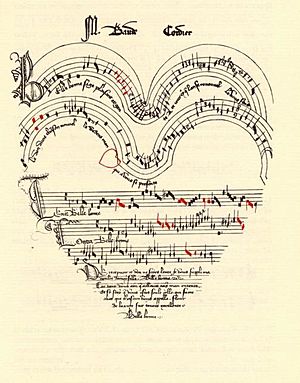Baude Cordier facts for kids
Baude Cordier was a French composer who lived a long time ago, in the early 1400s. He was known for a special style of music called ars subtilior, which means "more subtle art." This music was very complex and fancy.
Not much is known about Cordier's life, but we do know he was born in a place called Rheims in France. He also had a special degree called a Master of Arts. Some people think he might have been a musician named Baude Fresnel, who played the harp and organ for a duke, but this isn't certain.
Cordier is famous for his really cool and unusual ways of writing music. He would often make the music notes look like shapes that matched the song's topic! For example, one of his love songs, Belle, Bonne, Sage, was written on a music sheet shaped like a heart. Another song, Tout par compas suy composés, had notes arranged in many circles. This creative way of writing music is thought to have inspired other composers much later on.
Who was Baude Cordier?
Some people believe that Baude Cordier might have been a pen name (a fake name used by a writer or artist) for another musician named Baude Fresnel.
Cordier's Music Style
Cordier's musical pieces are great examples of the ars subtilior style. This was a very fancy and detailed way of writing music in the late Middle Ages.
One interesting thing Cordier did was use "red note notation," also called coloration. This was a special way of writing notes where changing the color of a note (often to red) would change its rhythm. It was like a secret code for musicians to play the music differently! This style of music and notation is sometimes called "mannerism" because it was so unique and artistic.
His Surviving Songs
Ten of Cordier's non-religious songs are still around today. Most of these are called rondeaux, which were a popular type of song back then.
- Some of his songs, like "Amans amés secretement" (which means "Lovers, love discreetly"), are very complex with lots of tricky rhythms, typical of the ars subtilior style.
- Other songs, like "Belle, Bonne, Sage" (meaning "Beautiful, Good, Wise"), are simpler and focus more on a beautiful, flowing tune.
Two of Cordier's songs are found in a very old book called the Chantilly Manuscript. These songs are famous examples of something called eye music. Eye music is when the way the music is written down looks like something special.
- The love song "Belle, Bonne, Sage" is written in the manuscript in the actual shape of a heart!
- Another song, a circular canon called "Tout par compas suy composés" (meaning "With a compass was I composed"), is also eye music. The entire song is written in a circle!
Many people think that Cordier's creative and experimental ways of writing music inspired later composers. For example, some believe his ideas influenced pieces like Refrain by Karlheinz Stockhausen and Je ne pouroye by Gilles Binchois. Cordier's music was also among the first in Western music to include instructions for musicians on how to play his special notation.
He also wrote a piece for a Mass (a type of church service music) found in the Apt Manuscript. This piece is in a simpler style, more like the music from the 1400s.
List of Baude Cordier's Compositions
Here are some of the known musical pieces by Baude Cordier:
- Gloria: A Mass movement for 3 voices.
- Dame excellent ou sont bonté: A Ballade for 4 voices.
- Amans, amés secretement: A Rondeau for 3 voices.
- Belle, bonne, sage, plaisant: A Rondeau for 3 voices.
- Ce jour de l'an que maint: A Rondeau for 3 voices.
- Je suy celuy qui veul: A Rondeau for 3 voices.
- Pour le deffault du noble dieu Bachus: A Rondeau for 3 voices.
- Que vaut avoir qui ne vit: A Rondeau for 3 voices.
- Se cuer d'amant par soy: A Rondeau for 3 voices.
- Tant ay de plaisir et de desplaisance: A Rondeau for 3 voices.
- Tout par compas suy composés: A Rondeau for 3 voices.
No other works by Baude Cordier are known to exist today.
See also
- Eye music
- In Spanish: Baude Cordier para niños



